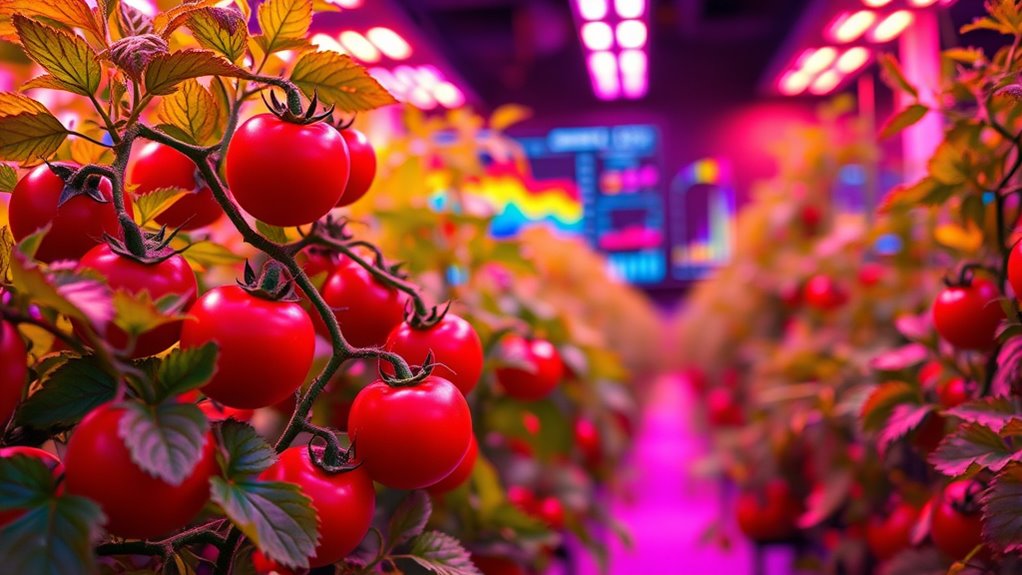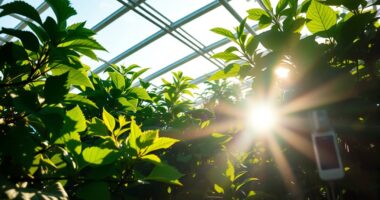By adjusting the light spectrum to match the specific needs of tomato plants, you can boost yields by up to 20%. Spectrum shifting optimizes red and blue wavelengths to improve photosynthesis, fruit quality, and plant health. Proper calibration and uniform light distribution are key for the best results. If you want to discover the most effective techniques and how to implement them for your crop, there’s more to explore on this topic.
Key Takeaways
- Spectrum shifting enhances tomato yields by approximately 15-20% through optimized light spectrum management.
- Precise red and blue light adjustments stimulate photosynthesis and flowering, boosting crop productivity.
- Uniform spectrum calibration across the canopy ensures consistent growth and maximized yield potential.
- LED technology enables targeted spectrum tuning, improving fruit quality and overall plant health.
- Combining spectrum shifting with monitoring and data-driven practices leads to sustainable, high-yield tomato cultivation.
Understanding Spectrum Shifting and Its Role in Tomato Growth

Since light plays a crucial role in tomato growth, understanding spectrum shifting becomes essential for maximizing yields. Spectrum shifting involves adjusting the light spectrum to enhance photosynthesis efficiency, which directly impacts plant health and fruit development. When you optimize the light wavelengths, you improve light absorption by chlorophyll molecules, allowing your tomatoes to convert more light into energy. This process ensures the plant’s metabolic activities run smoothly, leading to faster growth and better fruit quality. By focusing on spectrum shifting, you can supply your plants with the specific light bands they need most, especially during critical growth stages. Additionally, selecting the right lighting environment and understanding light spectrum management can further enhance crop productivity. Ultimately, this targeted approach boosts overall productivity and ensures your tomato plants reach their full potential.
Key Light Spectrum Components That Influence Photosynthesis
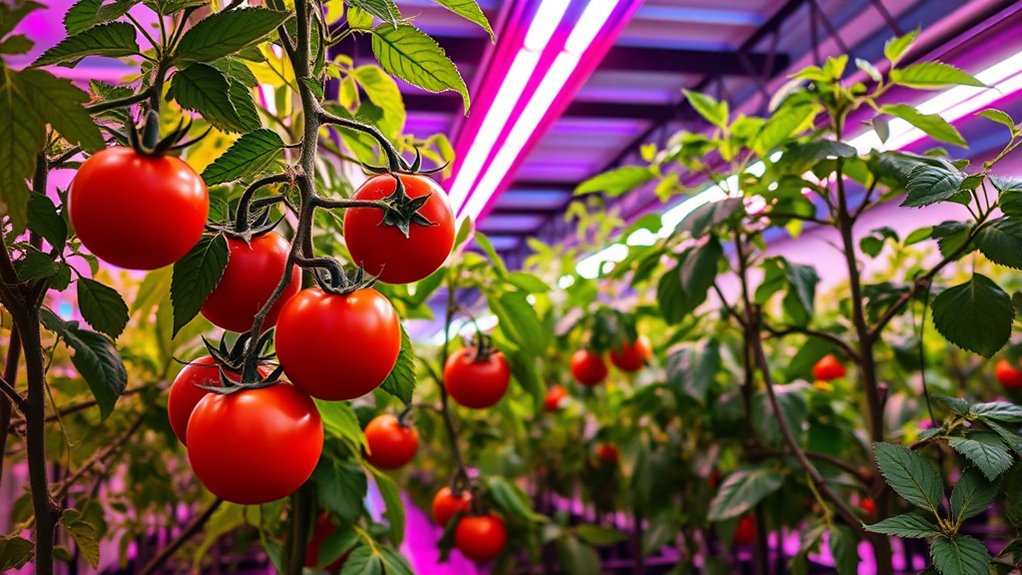
You need to focus on the specific wavelengths that maximize photosynthesis, especially in the red and blue spectrum. Red light promotes flowering and fruit production, while blue light encourages healthy leaf growth. Understanding how these wavelengths work together helps you optimize your tomato plants’ growth conditions. For optimal results, consider the light spectrum components that influence photosynthesis and how they can be adjusted to enhance plant health and yield.
Optimal Wavelengths for Growth
Understanding which wavelengths of light most effectively promote tomato growth is vital for optimizing photosynthesis. Generally, blue and red light are most effective, as they directly influence the photosynthetic process. Blue light enhances shade tolerance by encouraging compact, sturdy plants, which can better withstand low-light conditions. Red light promotes rapid growth and flowering, boosting overall yield. Additionally, targeted spectrum management can improve pest resistance, as healthier, stronger plants are less vulnerable to pests. While other wavelengths like green have lesser roles, focusing on blue and red ensures maximum energy absorption. Adjusting light spectra to match these wavelengths helps maximize photosynthesis efficiency, leading to healthier plants and higher yields. Proper spectrum selection is therefore essential for advancing tomato cultivation success.
Red and Blue Light Roles
Red and blue light are the most critical wavelengths for driving photosynthesis in tomato plants. These colors dominate the plant photoreceptors that regulate growth and development. Red light influences processes like flowering and fruit production by activating phytochromes, a type of plant photoreceptor sensitive to the red spectrum. Blue light, on the other hand, stimulates chlorophyll production and enhances stomatal opening, which improves carbon dioxide intake. Together, these wavelengths optimize the color spectrum that supports efficient photosynthesis. By providing precise red and blue light, you can boost plant health, increase yields, and improve fruit quality. Understanding the roles of these key spectrum components allows you to tailor lighting systems for maximum tomato productivity, leveraging the natural functions of plant photoreceptors. Color spectrum plays a crucial role in maximizing photosynthetic efficiency and plant growth.
Experimental Results: Yield Increases Across Different Spectrum Shifting Techniques
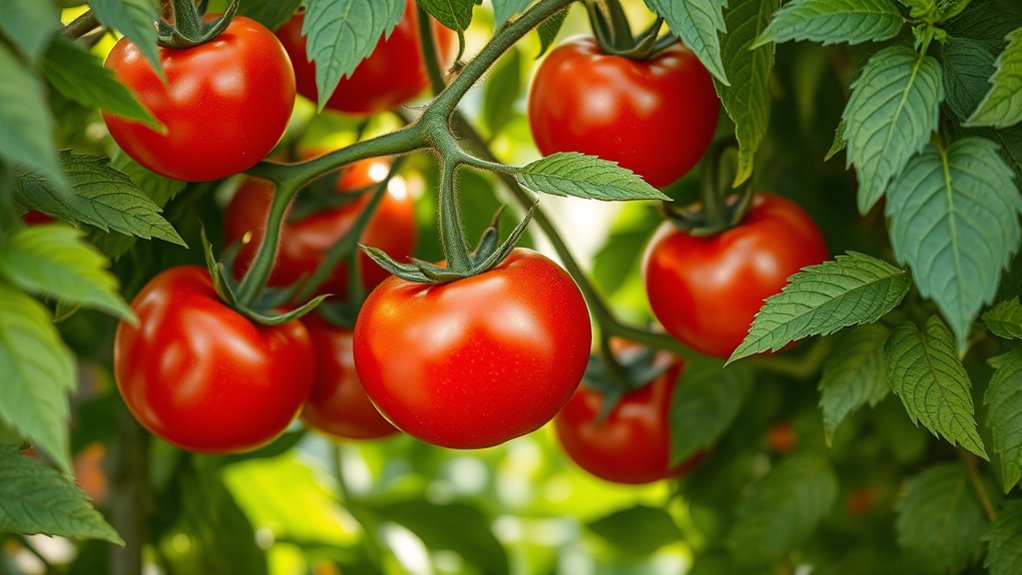
Experiments show that shifting the light spectrum can notably boost tomato yields, but the impact varies with the technique used. Some methods prove more effective, leading to higher increases in fruit production, while others show modest gains. Understanding these yield improvement metrics helps you choose the best spectrum shifting approach for your setup. Proper installation and venting of equipment are essential for optimal results and safety.
Spectrum Shift Impact
Different spectrum shifting techniques have demonstrated significant potential in boosting tomato yields, with each method producing measurable increases in productivity. These improvements depend heavily on precise spectral calibration to guarantee the correct light wavelengths target plant growth stages effectively. Additionally, maintaining light uniformity across the canopy plays a vital role in maximizing results, preventing uneven growth and optimizing resource use. By adjusting the spectrum, researchers have observed consistent yield increases, often around 15-20% compared to control groups. These gains are directly linked to better photosynthetic efficiency and nutrient utilization. Overall, the impact of spectrum shifting on tomato production proves promising, provided that calibration and light distribution are carefully managed to achieve the best possible outcomes. Proper spectral management can also influence plant health and reduce stress during critical growth phases.
Technique Efficacy Variations
Various spectrum shifting techniques have shown varying degrees of success in increasing tomato yields, with some methods outperforming others. LED configurations and spectrum optimization play key roles in these differences. For example, specific LED setups can target ideal light wavelengths, boosting photosynthesis efficiency. The table below highlights how different spectrum shifting methods perform:
| Technique | Yield Increase | Notes |
|---|---|---|
| Narrowband LEDs | High | Precise spectrum tuning |
| Broad spectrum LEDs | Moderate | Less targeted but versatile |
| Multi-wavelength | Variable | Depends on configuration |
Your choice of spectrum optimization strategy impacts results considerably. Some LED configurations yield better crop growth, emphasizing the importance of selecting effective spectrum shifting techniques tailored to your setup. Natural materials like wood or linen can be incorporated into the lighting fixtures or decor to enhance authenticity.
Yield Improvement Metrics
Recent studies demonstrate that spectrum shifting techniques can markedly boost tomato yields, with measurable increases varying based on the method used. When properly calibrated through spectrum calibration, these techniques optimize light absorption, leading to significant photosynthesis enhancement. Experiments show that targeted spectrum adjustments can improve yield metrics by up to 20%. Different approaches, such as shifting red or blue wavelengths, consistently outperform control groups. The data indicates that precise spectrum calibration is essential to maximizing photosynthesis efficiency and, consequently, crop output. By quantifying yield improvements, researchers confirm that spectrum shifting not only boosts biomass but also enhances fruit quality. These metrics highlight the potential for fine-tuning light spectra to achieve consistent, scalable yield increases in tomato cultivation. Proper spectrum calibration plays a crucial role in maximizing the benefits of these techniques.
Impact of Spectrum Shifting on Fruit Quality and Nutritional Content
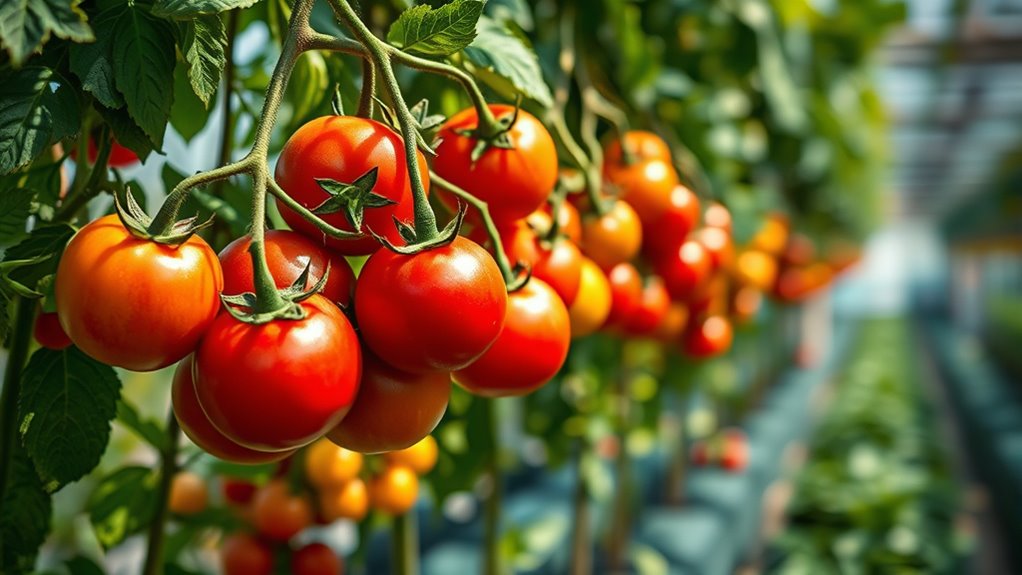
Shifting the light spectrum used in tomato cultivation can substantially influence both fruit quality and nutritional content. By optimizing the spectrum, you can enhance flavor, texture, and color, making your tomatoes more appealing and nutritious. Different wavelengths affect the synthesis of key nutrients like lycopene and vitamin C, leading to healthier produce. Additionally, tailored spectrum shifts can strengthen plant defenses against plant disease and reduce pest infestations, minimizing the need for chemical controls. This not only improves fruit quality but also contributes to safer, more sustainable production. Adjusting the spectrum offers a dual benefit: boosting nutritional value while supporting plant health. Incorporating remote work practices such as flexible scheduling can also facilitate ongoing research and monitoring of these lighting adjustments, leading to more effective cultivation strategies. As a result, your tomatoes become more marketable and resilient, ensuring better yields and quality in every harvest.
Practical Applications and Implementation Strategies for Growers
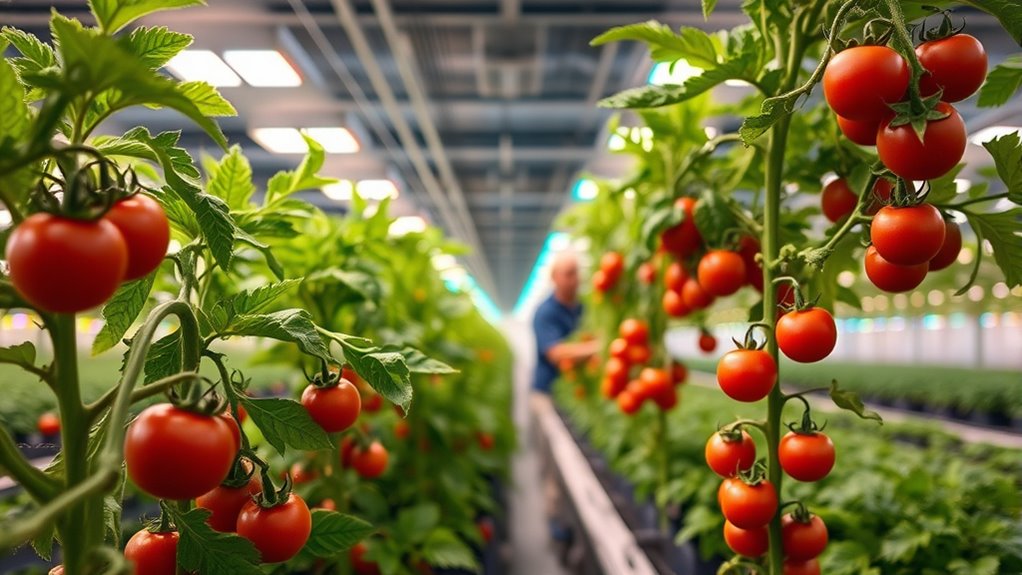
To effectively implement spectrum adjustments in your tomato cultivation, start by investing in LED technology that allows precise control over light wavelengths. These advanced systems enable you to tailor light spectra to optimize plant growth, flowering, and fruiting phases. Combine spectrum shifting with proper nutrient management to maximize yields and fruit quality; for example, adjust nutrient supply to match the plant’s increased photosynthetic efficiency under specific light conditions. Regularly monitor plant responses and make incremental changes to your lighting and nutrient strategies. Keep detailed records to identify which spectrum settings produce the best results. This approach ensures you’re making data-driven decisions, improving overall productivity while reducing resource waste. Precise control over light and nutrients is key to translating spectrum shifting benefits into real-world gains. Additionally, understanding how different light spectrums influence plant physiology can help refine your growth strategies for even better outcomes.
Future Perspectives and Innovations in Light Spectrum Technologies
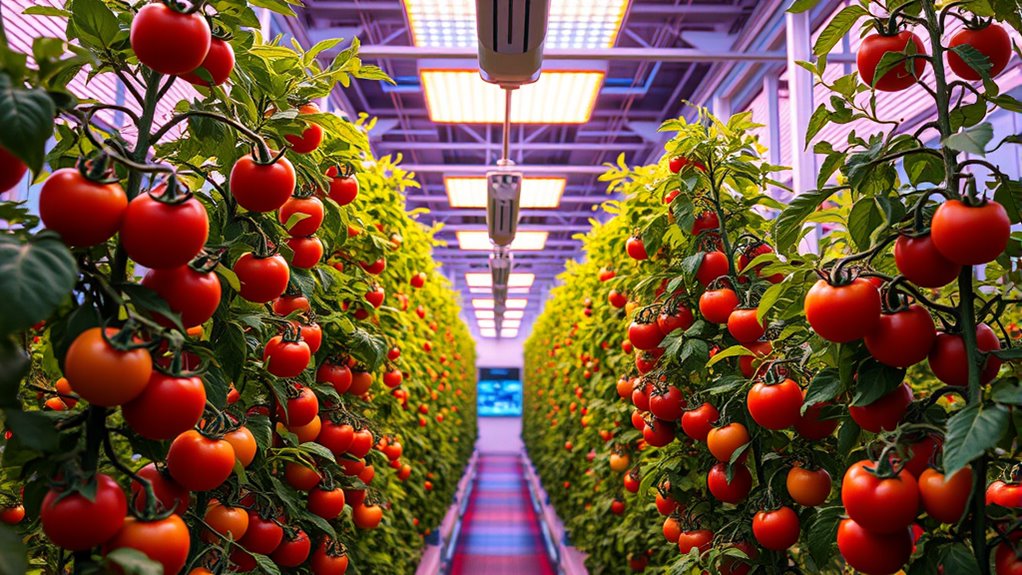
Advances in light spectrum technologies are poised to revolutionize tomato cultivation by enabling even more precise and adaptable control over plant growth conditions. Future innovations include integrating genetic modification with spectrum-shifting systems to enhance pest resistance and yield. These developments could allow you to tailor light spectra for specific plant traits, reducing reliance on chemical pesticides. Emerging technologies may also incorporate AI-driven adjustments, optimizing spectra in real-time. By combining spectrum control with genetic advances, you’ll gain a powerful tool to improve crop resilience and productivity. Proper storage of crops and technologies will be essential for maximizing these benefits.
Frequently Asked Questions
How Does Spectrum Shifting Affect Tomato Plant Disease Resistance?
You might wonder how spectrum shifting impacts your tomato plants’ disease resistance. This genetic modification technique can enhance your plants’ ability to resist diseases by optimizing light absorption, which strengthens their immune responses. Additionally, spectrum shifting can reduce your reliance on pesticides, making your farming more sustainable. By improving disease resistance naturally, you help protect your crops while promoting pesticide reduction, leading to healthier yields and a better environment.
What Are the Cost Implications of Implementing Spectrum Shifting Technology?
You might think spectrum shifting costs are high, but a careful cost analysis shows it can be cost-effective. The equipment investment initially requires funds, but improved yields and disease resistance can offset these expenses over time. While upfront costs are notable, the long-term benefits—such as reduced chemical use and higher productivity—make spectrum shifting a worthwhile investment, especially when considering the potential for increased tomato yields and sustainable farming practices.
Can Spectrum Shifting Be Customized for Different Tomato Varieties?
You can customize spectrum shifting for different tomato varieties by leveraging genetic modification techniques, allowing precise adjustments to enhance specific traits. This approach supports crop diversification, enabling you to optimize yield and resilience across various tomato types. Tailoring spectrum shifting guarantees you meet unique growth requirements, making it a versatile tool in modern agriculture. By customizing, you improve efficiency and productivity, ultimately benefiting your farming operations and crop quality.
How Does Spectrum Shifting Influence Tomato Plant Stress Tolerance?
Think of spectrum shifting as tuning a radio to the perfect station. It enhances photosynthesis efficiency, helping your tomato plants convert light into energy more effectively. This improved light absorption also boosts nutrient absorption, making plants more resilient to stress. By optimizing these processes, spectrum shifting acts like a shield, increasing your tomato plants’ stress tolerance and helping them thrive even in challenging conditions.
Are There Environmental Impacts Associated With Spectrum Shifting Equipment?
You should consider the environmental concerns linked to spectrum shifting equipment, as it can affect nearby ecosystems through light pollution or energy use. Regulatory challenges may also arise, requiring adherence to local laws and standards for light emissions. These factors could impact your implementation plans, so it’s crucial to assess potential ecological impacts and stay compliant with regulations to guarantee responsible use of spectrum shifting technology.
Conclusion
By shifting light spectra, you can boost tomato yields like a gardener tuning a delicate instrument. This technique fine-tunes the growth environment, enhancing photosynthesis and fruit quality. As you explore spectrum shifting, remember it’s a powerful tool that can transform your tomato production. With ongoing innovations, you’re poised to harvest healthier, more abundant tomatoes—making your efforts as rewarding as a ripe, sun-kissed harvest on a summer day.
